Are you having trouble deciding which kind of succulent would be best for your garden? Choosing the ideal addition to your indoor garden can be intimidating because there are so many varieties of succulents!
In this post, we examine our top succulent varieties, with descriptions and images of each one!
1. Chandelier Plant
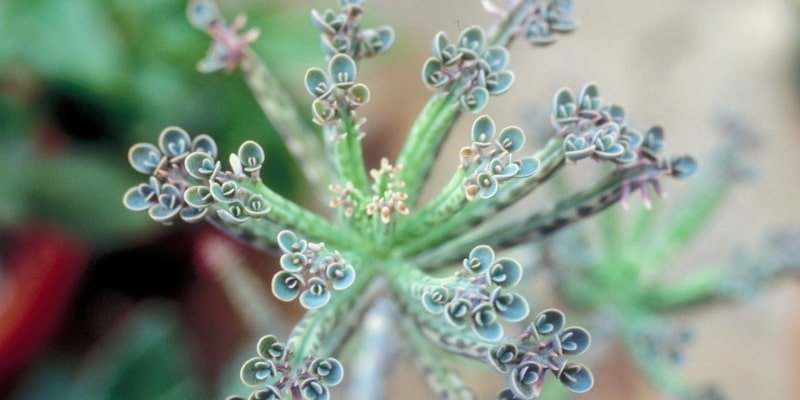
Scientific Name: Kalanchoes
Plant Type: Perennial
Plant Size: 8-12 inches tall
Watering Needs: The top 1-2 inches of soil are dry
Sun Exposure: Partial sun
Succulents that don’t look like succulents include chandelier plants. This succulent bears tiny flowers that range in colour from red to pink to white to yellow. Its leaves are slender and glossy.
Even though the succulent is a perennial and will keep blooming, many people treat it like an annual once the blossoms fade. However, the blossoms usually return in the summer or autumn.
Furthermore, although these succulents enjoy heat, filtered light is the best option to prevent the foliage from burning.
2. Hens and Chicks

Scientific Name: Echeveria elegans
Plant Type: Perennial
Plant Size: 1-4 inches
Watering Needs: The top 1-2 inches of soil are dry
Sun Exposure: Full sun to partial sun
The Mexican snowball, Mexican gem, or white Mexican rose are other names for this breed of hens and chicks. It almost has the appearance of an artichoke, but with plumper leaves and a paler green hue, more akin to that of jade stones.
From above, the plant appears symmetrical and layered, resembling a tiny cactus shaped like a rose. Since many varieties of hens and chicks only reach a height of a few inches, they frequently grow together and cover the ground.
3. Larryleachia

Scientific Name: Larryleachia cactiformis
Plant Type: Perennial
Plant Size: 4-7 inches
Watering Needs: The top 1-2 inches of soil are dry; Keep dry in the winter
Sun Exposure: Full sun
The Larryleachia succulent has a peculiar appearance. They resemble a little, wrinkled watermelon with tiny red stars on top and grow into one large lump. The flower blossoms, which resemble slender starfish with a grip in the center, are represented by the red stars.
This is a rare find if you’re looking for an exotic and slightly unusual succulent to add to your collection. It will draw the interest of neighbours and friends, and if planted in a warm location, it will flourish with very little care—just give it some sunshine!
4. Little Jewel
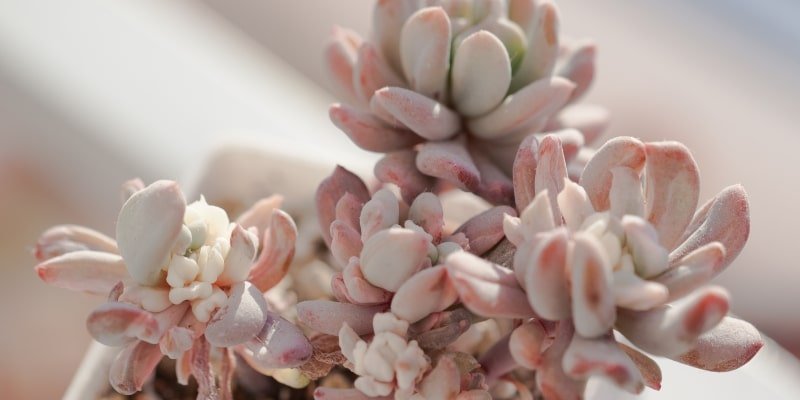
Scientific Name: Pachyveria haagei
Plant Type: Perennial
Plant Size: 3-7 inches
Watering Needs: The top 1-2 inches of soil are dry
Sun Exposure: Full sun to partial shade
The little jewel succulent, also known as the jeweled crown, grows in exquisitely simple and attractive rosettes. They have a lot of big cactus leaves that grow out and up from the roots, giving them a mint or pea green colour.
For an eye-catching effect, the edges may turn pink, and in certain instances, the entire plant may turn pinkish-red. Despite being common, this plant is among the most popular succulents since it needs a lot of warmth.
5. Lobster Claws
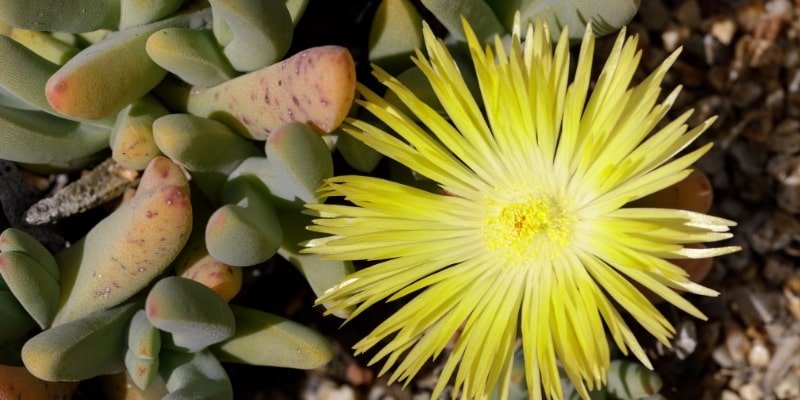
Scientific Name: Cheiridopsis denticulata
Plant Type: Perennial
Plant Size: 2-6 inches
Watering Needs: The top 1-2 inches of soil are dry
Sun Exposure: Full sun
The cheiridopsis is a small succulent with a subtle, charming appearance that doesn’t get particularly big or tall. It nearly looks like giant grass blades. They are usually only one or two inches tall, yet they can grow as tall as six inches, though this is rare.
However, cheiridopsis requires minimal care; once they develop, you can leave them in the sun to flourish and effortlessly add some greenery to your house or yard.
6. Opalina

Scientific Name: Graptoveria
Plant Type: Perennial
Plant Size: 6-8 inches
Watering Needs: The soil is completely dried out
Sun Exposure: Full sun
When the Opalina plant matures, its adorable, small succulent form transforms into a rich purple hue. It’s a unique hybrid succulent made of Graptopetalum and Echeveria plants.
The leaves are shaped like pointed teardrops and are initially mint green, turning pink around the margins or, on older plants, dusty purple. The big bud is surrounded by chunky leaves that grow in concentric circles. It only requires full sun to thrive because it stores abundant water.
7. Pig’s Ear
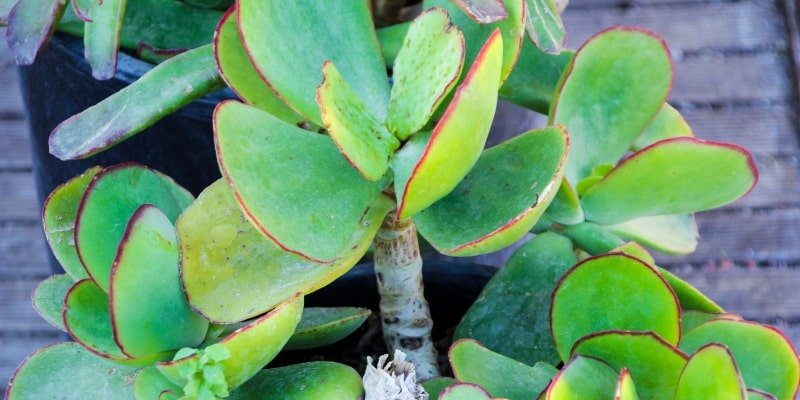
Scientific Name: Cotyledon
Plant Type: Perennial
Plant Size: 1-4 feet
Watering Needs: The soil is completely dried out
Sun Exposure: Full sun to partial shade
This succulent is among the more beautiful varieties. It features light green, flat, tear-shaped leaves, but as it ages, the leaves may turn pink or crimson, which is how it gained the nickname “pig’s ear.”
Although they have the ability to grow straight, their leaves and branches tend to droop as they get closer to one foot in height, which makes them perfect for a beautiful hanging plant in your house.
8. Prenia

Scientific Name: Prenia pallets
Plant Type: Perennial
Plant Size: 2-4 inches
Watering Needs: The top 1-2 inches of soil are dry
Sun Exposure: Full sun
Prenia plants can slither over two feet. The grey-green foliage can be egg-shaped or narrow and elongated. During the summer, the plant produces daisy-like flowers that range in colour from pale pink to white or yellow. In South Africa, they are often seen by the sides of the road.
If you’re apprehensive about gardening, this is an excellent succulent to plant to boost your gardening confidence because it grows really quickly! To prevent it from taking over the rest of your garden, plant it in a container.
9. Snake Plant

Scientific Name: Sansevieria trifasciata
Plant Type: Perennials
Plant Size: 8 inches – 12 feet
Watering Needs: The soil is nearly dried out
Sun Exposure: Full sun to partial shade
Although it is a well-known plant, many people are unaware that the snake plant is a succulent. It is also known as viper’s bowstring hemp, mother-in-law’s tongue, and Saint George’s sword. It rises straight up and is tall.
One of the nicknames comes from the broad, thin leaves that resemble a sword’s blade. Though most home snake plants only reach a height of approximately a foot, which is enormous for a succulent, they can grow enormously given the correct circumstances.
10. Ox Tongue

Scientific Name: Gasteria
Plant Type: Perennial
Plant Size: 4-24 inches
Watering Needs: The top 1-2 inches of soil are dry
Sun Exposure: Full sun
The ox tongue succulent is characterized by its large, flat leaves with rounded tips that resemble tongues. They appear to be fanned out as they grow in tandem with each other rather than in all directions. With flecks of brilliant green, yellow, or white sporadically throughout, the leaves have a deep green hue.
Despite their more straightforward appearance compared to other succulents, they can offer your plant a special relationship with the growth of their leaves.
11. Plover Eggs

Scientific Name: Adromischus cooperi
Plant Type: Perennial
Plant Size: 2-6 inches
Watering Needs: The top 1-2 inches of soil are dry
Sun Exposure: Full sun
Because plover eggs are among the rarest varieties of succulents, enthusiasts of exotic plants highly value them. Although it takes a while to grow, this plant is worth the wait.
It begins as tiny, succulent leaves that are squishy, but as it grows, it takes on more and more tree-like characteristics; extremely mature leaves can even begin to resemble chunky bonsai trees. The leaves change to powdery hues, including purple, brown, and green.
12. Revolut Flower Succulent

Scientific Name: Tromotriche revoluta
Plant Type: Perennial
Plant Size: 7-10 inches
Watering Needs: The top 1-2 inches of soil are dry
Sun Exposure: Partial sun
This succulent is a long-lasting perennial with a red, purple, or pink star-shaped flower. The blooms resemble miniature starfish, just like many other succulents.
As a form of defense, the succulent leaves have sharp spikes all over them and grow straight up. There are instances where the stars’ points remain partially open, giving the appearance of a softer flower with rounded edges.
13. Spiderwort

Scientific Name: Tradescantia
Plant Type: Perennial
Plant Size: 5-10 inches
Watering Needs: The top 1-2 inches of soil are dry
Sun Exposure: Indirect sunlight
The spiderwort plant, also called the Wandering Jew, has long, thin leaves that don’t always resemble succulents and a rich purple colour.
The leaves can have a subtle green line running through them, or they can be completely purple, akin to the colour of red wine. Although it’s not ideal, plants that receive a lot of direct sunlight may turn pink, which usually indicates they should be taken out of the sun.
14. Starfish Plant
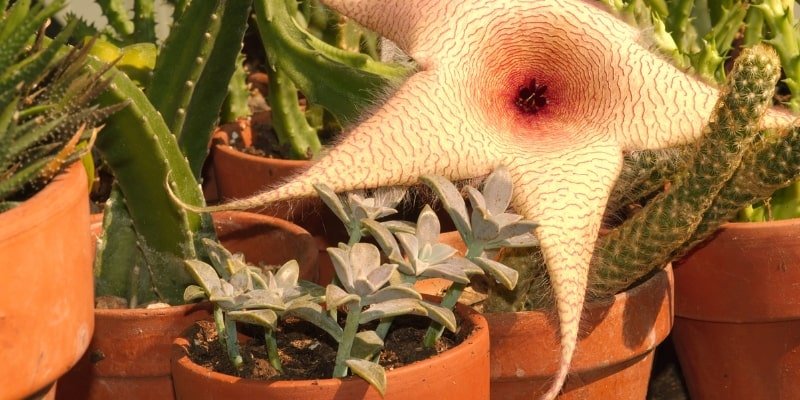
Scientific Name: Orbea variegata
Plant Type: Perennial
Plant Size: 4-20 inches
Watering Needs: The soil is completely dried out; Keep it dry in winter
Sun Exposure: Full sun
The starfish succulent, known as a carrion flower, features unusual star-shaped blossoms that are deep purple in colour. Having this succulent in your house or yard is a lot of fun since, even among a sea of other plants, it has a unique and striking appearance.
Since the stems and branches are frequently prickly, getting too close to them could result in blood loss. But if it gets enough sunlight, it can withstand various conditions.
15. Tavaresia

Scientific Name: Tavaresia barklyi
Plant Type: Perennial
Plant Size: 5-10 inches
Watering Needs: The soil is completely dried out; Keep it dry in the winter
Sun Exposure: Light shade
One of the most striking succulents is this quirky tubular plant, which has trumpet-shaped flowers. Although the muted colours give it the appearance of a regular cactus, the beautiful blossoms frequently draw attention.
The flowers emerge from the stems, which are thick, knobby cactus arms that resemble slender bowling pins raised in the earth.
16. Agave

Scientific Name: Agavoideae
Plant Type: Perennial
Plant Size: 1 inch-8 feet
Watering Needs: The soil is completely dried out
Sun Exposure: Full sun
Due to its widespread use in recipes and as a sugar substitute in cocktails, agave is a well-known succulent. Keep agave plants in a warm, bright place where they will flourish because they enjoy the heat.
Because their leaves are pointy, don’t injure yourself while admiring them. Large, symmetrical rosettes made of the leaves give off a pretty, striking appearance.
17. Ant Plant

Scientific Name: Dischidia actinides
Plant Type: Perennial
Plant Size: 1-3 feet
Watering Needs: The top 1-2 inches of soil are dry
Sun Exposure: Full sun
The thin, floppy leaves of the ant-plant make it another succulent that most people don’t consider to be one. Despite requiring a little more care than other succulents because of its smaller water storage capacity, this one is nonetheless relatively hardy.
Planting them in hanging pots is expected because of their long, thin leaves and branches that eventually drop downward. It seems magical, as though it were from a hidden garden.
18. Astroworthia

Scientific Name: Astroworthia bicarinata
Plant Type: Perennial
Plant Size: 6 inches-3 feet
Watering Needs: The soil is completely dried out
Sun Exposure: Full Sun
A lesser-known succulent, Astroworthia has gorgeous chunky leaves that climb up the stem in shades of green and red. To ward against predators, they feature very prickly leaves with protective notches.
However, when they get older, they turn a gorgeous pink or crimson colour that looks great in your garden or house. However, they usually don’t get excessively tall, which makes them perfect for pots or beside pathways. Just make sure they receive lots of sunlight—they don’t thrive in the shade.
19. Babies Toes

Scientific Name: Fenestraria
Plant Type: Perennial
Plant Size: 3-6 inches
Watering Needs: The top 1-2 inches are dry
Sun Exposure: Full sun
The common name of this succulent is rather fitting since the leaves and stems resemble baby toes in appearance and grow thick and short. When the leaves fully develop, which takes up to six inches, they resemble substantial grass blades.
They don’t perform well in the cold or shade, but they are reasonably simple to care for. If you reside in a zone lower than nine, they must live inside. And if they are kept out of the sun, they will pass away quite rapidly.
20. Chinese Dunce Cap

Scientific Name: Orostachys japonica
Plant Type: Biennial
Plant Size: 0.5-2 inches
Watering Needs: The top 1-2 inches of soil are dry
Sun Exposure: Full sun to partial sun
This succulent appears delicate and fanciful. It is green, but it has a hint of white that overlaps the green to give the impression that it is a sophisticated, icy plant.
Because it differs from the standard green found in many other houseplants, people adore having them in their collection of plants.
Thick, round leaves overlap in concentric circles to form the flower of a cactus. However, each blossom’s center resembles a dunce cap, which is why the ridiculous moniker emerged. Unlike many other succulents, these will grow in colder climates.
21. Concrete Leaf

Scientific Name: Titanopsis calcarea
Plant Type: Perennial
Plant Size: 1-3 inches
Watering Needs: The soil is completely dried out; Keep it dry in the winter
Sun Exposure: Full sun
This succulent, also known as the Carpet Leaf or Sheep’s Tongue, has tough leaves that resemble concrete yet are softer to the touch. Usually bluish-green or light grey in colour, the thick, wavy leaves may produce tiny yellow flowers from the mats at specific times of the year.
They have an unusual grey appearance by nature, which leads many people to believe they are dying. Although they are relatively hardy, they do require intense heat and sunlight.
22. Ice Plant

Scientific Name: Corpuscularia
Plant Type: Perennial
Plant Size: 8-12 inches
Watering Needs: The top 1-2 inches of soil are dry
Sun Exposure: Full sun
Despite its common name, this succulent is not an excellent cold-weather plant and will not withstand a frost if left outdoors. But other than that, they’re pretty easy to maintain.
The reason it’s dubbed the “ice plant” is because the thick, green cactus leaves can occasionally take on a cool blue hue with green undertones. As the plant ages, the leaves get even more massive and resemble ice cubes.
23. Karoo Rose

Scientific Name: Lapidaria margaretae
Plant Type: Perennial
Plant Size: 1-3 inches
Watering Needs: The soil is completely dried out
Sun Exposure: Full sun
The karoo rose is a little succulent with fantastic beauty that won’t grow very large. It saves an enormous amount of water for the little plant because it develops fat clumps for leaves.
The plant has an odd and hefty appearance due to what appear to be little triangular pebbles adhered together. If someone doesn’t tell you it’s a plant, you might not even know it! However, given proper care in bright light, it occasionally produces a lovely golden blossom in the middle of the leaves.
24. Liveforever
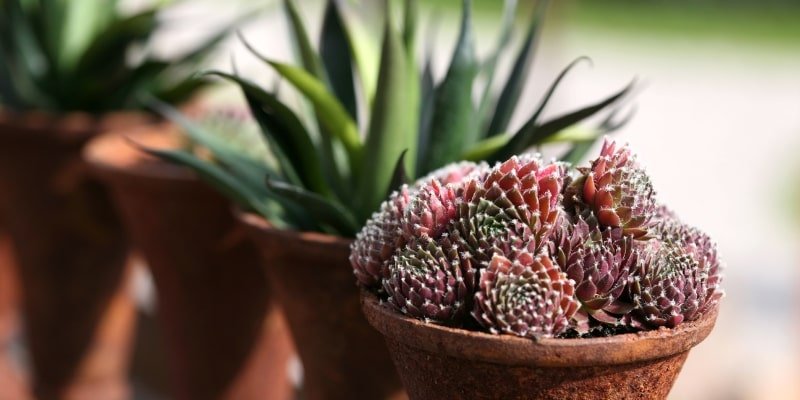
Scientific Name: Sempervivum
Plant Type: Perennial
Plant Size: 2-8 inches
Watering Needs: The top 1-2 inches of soil are dry
Sun Exposure: Full sun to partial shade
This succulent is highly resilient and will “live forever,” as its name implies. They are easy to take care of because they grow well in a wide range of hardiness zones. Certain types of this succulent have leave with purple undertones, which gives them a very distinctive appearance.
They can develop ground mats of rosettes in home gardens, as they do in the wild. However, they tend not to spread as much when cultivated in containers. These are sharp-edged, tiny, dense rosettes that may cut you.
25. Monanthes

Scientific Name: Monanthes pallens
Plant Type: Perennial
Plant Size: 3-6 inches
Watering Needs: The top 1-2 inches of soil are dry
Sun Exposure: Full sun
One kind of succulent with leaves that resemble geometric fractals is the month’s plant. The fine ridges on the stubby, spherical leaves captivate people’s attention; they appear too beautiful to be natural.
The plant has bumps from the little bunches of leaves that develop there. These are not ideal if you need a new plant urgently because they grow pretty slowly.
26. Roselings
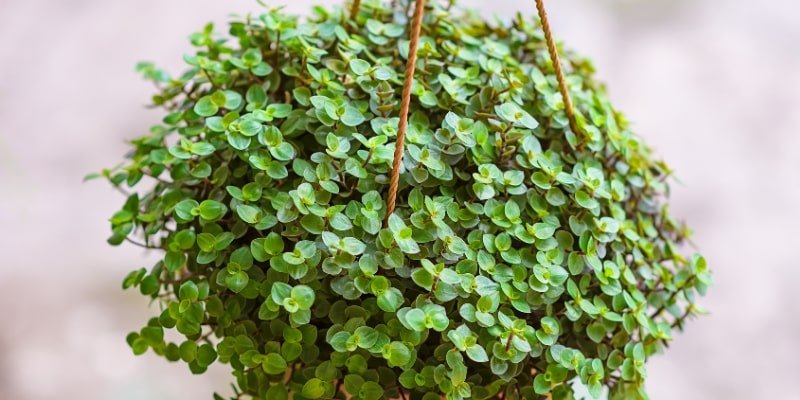
Scientific Name: Callisia repens
Plant Type: Perennial
Plant Size: 4-12 inches
Watering Needs: The top 1-2 inches of soil are dry
Sun Exposure: Full sun
A collision plant’s leaves don’t like those of a cactus, so you might not assume it’s a kind of succulent when you look at it. However, this low-growing succulent may liven up hanging pots or in your house and is quite easy to care for. It also looks like a fern.
The tiny and adorable leaves give your collection of plants a somewhat bushy appearance that enhances depth and volume.
27. Silver Dollar Plant

Scientific Name: Xerosicyos Dangly
Plant Type: Perennial
Plant Size: 1-4 feet
Watering Needs: The top 1-2 inches of soil are dry
Sun Exposure: Full sun to partial sun
Due to their ease of maintenance, silver dollar plants are a common type of succulent. Their perfectly round, meaty leaves, which set them apart from other plants, gave rise to their nickname.
Their slim branches add to the eye-catching and seductive appearance of the coin-shaped leaves. Although the plant appears delicate, it can withstand various temperatures and unfavourable conditions. Because it requires little care and looks good, it is a popular houseplant.
28. Stonecrops
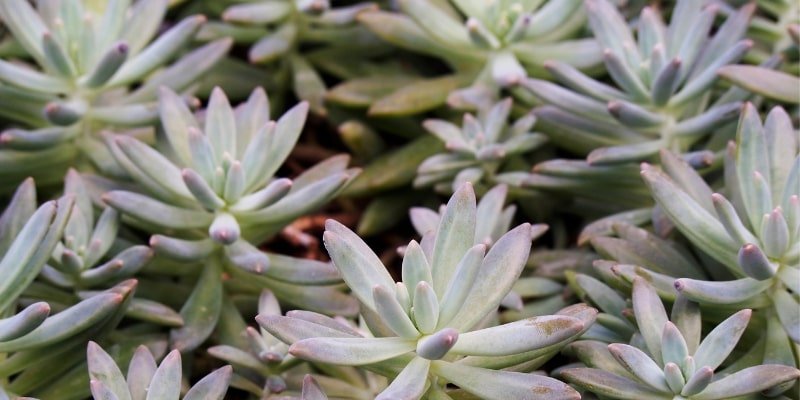
Scientific Name: Sedum allantoides
Plant Type: Perennial
Plant Size: 1-3 feet tall
Watering Needs: The top 1-2 inches of soil are dry
Sun Exposure: Full sun
The ideal conditions for stone crops are mild temperatures and indirect or filtered sunshine. However, they’re resilient plants that can withstand a lot of hardship before withering away. Plant enthusiasts often keep this succulent in their homes.
Its leaves and branches are soft and powdery, like the classic image of a cactus, but with additional little arms extending down the stem. Their subtle appearance and mint green colour make them quite popular.
29. Zebra Cactus

Scientific Name: Haworthia spp.
Plant Type: Perennial
Plant Size: 3-5 inches
Watering Needs: The top 1-2 inches of soil are dry
Sun Exposure: Full sun
You won’t need to water the zebra cactus often because it prefers full sun and dry weather. Its appearance is bold and spiky. If you bump into the plant too forcefully, the edges may pierce your skin, and when viewed from above, the spikes may occasionally form an intriguing star shape.
Certain cacti have rather bulky leaves, while others may have thinner ones. Usually, a plant’s ability to store water is reflected in the size of its leaves. There are numerous varieties of Haworthia to select from if the zebra plant’s appearance doesn’t appeal to you.
30. Sea Rocket

Scientific Name: Othonna
Plant Type: Perennial
Plant Size: 3-4 inches
Watering Needs: The soil is completely dried out
Sun Exposure: Full sun to partial shade
When conditions are good, the fleshy sea rocket succulent grows swiftly. Near the roots, it feels woody, but instead of reaching upward towards the sun, it grows pretty low to the ground and spreads out.
This plant is quite adorable because of its tightly packed leaves, which resemble little pickles. When the time comes for this succulent to blossom, tiny yellow and orange flowers will emerge from it.
31. Prince Albert Vygie

Scientific Name: Ebracteola wilmaniae
Plant Type: Perennial
Plant Size: 2-3 inches
Watering Needs: The top 1-2 inches of soil are dry
Sun Exposure: Full sun to partial sun
One of the cutest and most beautiful succulents is the Prince Albert Vygie succulent. Like aloe vera, it has long, thin leaves, but in the middle of two of the leaves often emerges a daisy-like flower.
The blooms, which might be pink, purple, or white, will add a beautiful pop of colour to your verdant yard. This plant, in contrast to other succulents, grows well in both wet and dry environments as long as it receives adequate sunlight.
32. Navelwort

Scientific Name: Umbilicus rupestris
Plant Type: Perennial
Plant Size: 3-10 inches
Watering Needs: The top 1-2 inches of soil are dry
Sun Exposure: Full sun to full shade
Another name for this succulent is wall pennywort, or penny-pies, which are all very amusing. One of the more unusual succulents, it thrives in moist, gloomy environments and cascades down cliff faces. Nevertheless, it also enjoys sunlight.
With tiny imprints in the middle, the leaves resemble belly buttons, even though they resemble lily pads! The moniker “navelworts” came about as a result. Living in a dry area can make it challenging to grow and maintain them because they prefer high humidity.
33. Living Stone

Scientific Name: Lithops
Plant Type: Perennial
Plant Size: 0.5-2 inches
Watering Needs: The top 1-2 inches of soil are dry
Sun Exposure: Full sun
The moniker “living stone succulent” comes from its actual stone-like appearance. These grow extremely low to the ground in nearly perfect spheres, with the leaves divided by a split down the center. They could be a subdued shade of copper, pale green, or even soft grey.
Stepping on one can happen if you’re not cautious. However, when you group several of them in a pot or piece of ground, they frequently produce a lively, multicoloured look that is attractive.
34. Lifesaver Plant

Scientific Name: Huernia
Plant Type: Perennial
Plant Size: 4-8 inches
Watering Needs: The top 1-2 inches of soil are dry; Keep dry in the winter
Sun Exposure: Full sun to partial shade
One of the strangest varieties of succulents is the lifesaving plant, which has a broad red ring inside its tubular leaves, giving it an intriguing but slightly menacing appearance. This is a popular addition to the collections of those who appreciate unusual or exotic plants.
And if it stays out of the frost, it is a hardy plant. However, in dry or moist locations, it can even survive with a few hours of sunlight per day. However, it likes warm, dry, sunny places, just like most other varieties of succulents.
35. Jade Plant

Scientific Name: Crassula ovata
Plant Type: Perennial
Plant Size: 3-6 feet
Watering Needs: The top 1-2 inches of soil are dry
Sun Exposure: Prefers full sun
One of the more hardy varieties of succulents is the jade plant, which can endure and flourish in various environmental circumstances. It resembles warm, sunny settings, but it can withstand a freeze in certain instances.
This succulent is one of the more popular house plants because of its straightforward appearance. Of the Crassula genus of plants, it is the most widely grown succulent and is frequently seen on display in botanical collections.
Tiny oval leaves assemble in clusters on branches and firmly climb upward. It will resemble a small tree and grow to be quite strong and tall with proper care!
36. Coral Plant

Scientific Name: Neohenricia
Plant Type: Perennial
Plant Size: 0.5-1 inch
Watering Needs: The top 1-2 inches of soil are dry
Sun Exposure: Full sun to partial shade
The coral plant, in contrast to most other kinds of succulents, enjoys occasional cool temperatures and even shade. Experts advise maintaining it in direct sunlight in the winter and moving it into partial shade in the summer.
This succulent requires minimal maintenance, but it does need a little more care than others. The plant develops very slowly, producing thick, tiny green leaf shoots. Although it doesn’t have the most striking appearance among succulents, it is hardy.
37. Chiovenda

Scientific Name: Pseudolithos
Plant Type: Perennial
Plant Size: 2-3 inches
Watering Needs: The top 1-2 inches of soil are dry; Keep dry in the winter
Sun Exposure: Full sun
The Chiovenda succulent has a peculiar appearance. Pseudo-lithos, the scientific term, means false stone. With all of their lumps and abnormalities, they resemble strange stones. These succulents are essentially just a jumble of plants without any leaves.
On top of the plant’s base, it occasionally produces a cluster of red, star-shaped flowers. The succulent almost has the appearance of an odd planet or other extra-terrestrial object. They detest the cold, yet they are quite hardy and can survive in some of the worst weather conditions.
38. Bunny Succulent

Scientific Name: Monilaria
Plant Type: Perennial
Plant Size: 1-6 inches
Watering Needs: The top 1-2 inches of soil are dry; when soil is completely dried out in winter
Sun Exposure: Full sun to partial sun
The lovely bunny succulent, commonly known as the string of pearls, develops incredibly slowly. It appears as though a string of pearl necklaces is emerging from a pot due to the tiny bulb leaves adorning the branches.
They can take years to grow to their full size because they are initially small. However, this tiny succulent is incredibly resilient; it can endure frosts, droughts, darkness, and other conditions while continuing to thrive year after year.
39. Aloe

Scientific Name: Aloe vera
Plant Type: Perennial
Plant Size: 1 inch-3 feet
Watering Needs: The top 1-2 inches of soil are dry
Sun Exposure: Full sun
The most well-known use of aloe is as a calming remedy for rashes and sunburns. It’s a remarkable little plant with a jelly-like material inside the leaves that provides natural cooling effects. It’s also a lovely, vivid green plant that looks great in any house.
Aloe can reach a height of three feet with proper drainage and enough sunlight; however, most varieties stay tiny when cultivated inside. Remember that it prefers a dry climate, so avoid overwatering it.
40. Deltoid-leaved Dew Plant

Scientific Name: Oscularia deltoides
Plant Type: Perennial
Plant Size: 10-12 inches
Watering Needs: The top 1-2 inches of soil are dry; Keep dry in the winter
Sun Exposure: Full sun
The peculiar thing about this succulent is that it grows well in rocky, relatively moist environments. It can be easily moved, repotted, or replanted because it draws much water from the atmosphere rather than from its roots. It’s a resilient plant that can withstand a lot.
From a distance, this succulent resembles a bushy flowering plant; up close, however, you can see that it is actually a cactus with chunky leaves and branches.
41. Lampranthus

Scientific Name: Lampranthus bicolor
Plant Type: Perennial
Plant Size: 6-12 inches
Watering Needs: The top 1-2 inches of soil are dry
Sun Exposure: Full sun
The succulents of the amaranthus are stunning and rather attractive. From a distance, they look like ordinary flowers, but up close, you can see that the stems and branches are incredibly thick and plump because they are packed with water.
Additionally, they can be found in many exquisite hues, including orange, purple, pink, blue, white, and yellow.
For a gardener searching for a vibrant, low-maintenance plant that is also rather colourful, this is the ideal choice. These succulents require very little water and plenty of sunshine and warmth!
42. Macho Mocha

Scientific Name: Mangave
Plant Type: Perennial
Plant Size: 8-20 inches
Watering Needs: The soil is completely dried out
Sun Exposure: Full sun to partial sun
The macho mocha is a terrific option if you want to make a statement with your succulent garden because it’s one of the most giant succulents on this list. It’s not the most colourful, though. Though it mostly has a brownish colour, sometimes it takes on an intensely dark purple hue—hence the name mocha.
Under rare circumstances, it can also be cultivated as a dark crimson colour. Since they are tough plants, they thrive in a variety of environments and, given enough time and protection from the cold, may even withstand a frost.
43. Stone Plant

Scientific Name: Dinteranthus vanzylii
Plant Type: Perennial
Plant Size: 1-2 inches
Watering Needs: The soil is completely dried out
Sun Exposure: Full sun
This succulent’s common name is spot-on since it resembles a bit of rock. Every one of them has two incredibly thick, bulbous leaves that can occasionally produce a little golden blossom in the center.
Due to its peculiar appearance, this succulent is well-liked by enthusiastic plant collectors who enjoy unusual and unusual plants. Once these succulents grow, you virtually never need to water them because the leaves hold so much water.
44. Turkish Stonecrop

Scientific Name: Rosularia platyphylla
Plant Type: Perennial
Plant Size: 0.25 to 0.50 feet
Watering Needs: The top 1-2 inches of soil are dry
Sun Exposure: Full sun
This succulent is so tenacious and resilient that its origins are somewhat unknown despite the fact that it has appeared in so many diverse areas.
This succulent might be ideal for you if you live in a cold, wet area because it can grow in zones 5 through 11, and if you bring it inside before it freezes, it might even withstand a frost. It resembles a bouquet of cacti because of the charming appearance of several clustered rosettes compressed together!
45. Afrikaans

Scientific Name: Odontophorus
Plant Type: Perennial
Plant Size: 3-8 inches
Watering Needs: The soil is completely dried out; Keep it dry in winter
Sun Exposure: Full sun
Adorable plants, Afrikaans succulents have flat, broad leaves that grow upward and gently curve over. A medium-sized flower will bloom in the center at specific periods of the year. Usually, the blossom is either yellow or white.
Occasionally, the leaves can develop into a type of peace sign before splitting apart. Although it prefers full sun, it may grow in a little partial shade. However, because the Afrikaans succulent requires very little water and can easily drown, the secret to caring for it is to keep it dry.
46. Chinese Jade
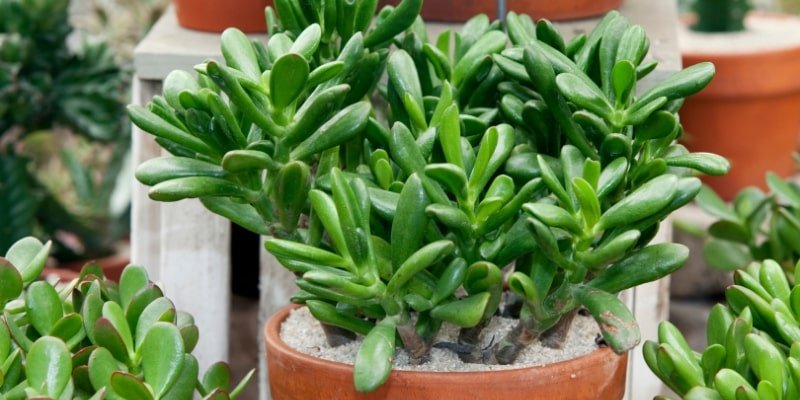
Scientific Name: Sinocrassula yunnanensis
Plant Type: Perennial
Plant Size: 2-4 inches
Watering Needs: The top 1-2 inches of soil are dry
Sun Exposure: Full sun
This little succulent’s gentle green colour and origins have earned it the name “Chinese jade.” Instead of having thin needles, they resemble a pile of sea urchins with chunky spikes growing in spiky spheres on top of one another.
Others may have a delicate jade hue, but many develop into a rich forest green hue as they age, and others may even become so dark as to appear black.
47. Fairy Elephant’s Feet

Scientific Name: Frithia pulchra
Plant Type: Perennial
Plant Size: 4-8 inches
Watering Needs: The soil is completely dried out
Sun Exposure: Full sun to partial sun
Despite having thick cactus leaves, fairy elephant’s feet are a lovely succulent that occasionally flowers a vibrant purple or pink blossom.
Although the baby toe succulent’s leaves resemble this plant’s, the blooming flowers give it a more fascinating appearance. Like most succulents, the club-shaped leaves are an eye-catching addition to your collection and require little maintenance—just lots of sun.
48. String of Hearts

Scientific Name: Ceropegia woodii
Plant Type: Perennial
Plant Size: 6 inches-12 feet
Watering Needs: The top 1-2 inches of soil are dry
Sun Exposure: Full to moderate sun
Ceropegia is a highly fascinating plant with a dark, scary aspect that is ideal for gothic gardeners. The thick, meaty leaves are not as colourful as the vivid green varieties of succulents, such as aloe, because of their subdued hue.
His plant is sometimes called the “string of hearts,” although only a few species of plants have been given that moniker and most of them are not succulents. They store enough water to survive on their own despite the thin leaves’ ability to deceive. They are simple to spread and highly popular.
49. Braunsia

Scientific Name: Braunsia maximiliani
Plant Type: Perennial
Plant Size: 5-10 inches
Watering Needs: The top 1-2 inches of soil are dry; Keep dry in the winter
Sun Exposure: Full sun
Braunsia is a highly active plant with bulky, triangular-looking leaves. Occasionally, they will also produce small purple blooms that will liven up your house or garden.
However, the dense leaves still hang over the pots and cover the ground, even without the little blooms. The plant resembles a hybrid of a cactus and ivy. This is a fantastic succulent to add to your collection if you’re a gardener who enjoys uncommon and exotic succulents.
50. Juttadinteria
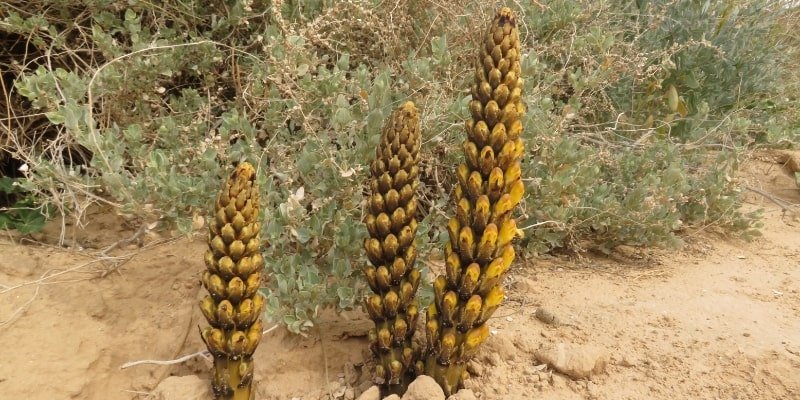
Scientific Name: Juttadinteria suavissima
Plant Type: Perennial
Plant Size: 4-10 inches
Watering Needs: The top 1-2 inches of soil are dry
Sun Exposure: Full sun
Another stylish succulent is Juttadinteria, which has leaves resembling cacti and a stunning blossom that emerges from the center. This succulent plant grows slowly and won’t get very large.
Because of their highly woody roots, they may begin to resemble infant trees if you are able to produce them to be really huge.
The clustering of the boat-shaped leaves gives the plant a complete appearance without appearing bushy. As long as it receives sunlight, this succulent is easy to maintain and looks stunning. But be patient—they do develop very slowly!
51. Pepper Elder

Scientific Name: Peperomia pellucida
Plant Type: Perennial
Plant Size: 6-18 inches
Watering Needs: The top 1-2 inches of soil are dry
Sun Exposure: Full sun to partial sun
This peperomia cultivar, sometimes called the Shining Bush plant or Man to Man, is not cold-tolerant and will swiftly die if the temperature drops too low. However, it flourishes in warm, humid climates because it enjoys a steamy, moist atmosphere.
Its leaves are thin and glossy, like those of a monstera or related plant, but its stems are bulky and succulent. The leaves are sometimes bicoloured, with stripes or margins of white or light green on a dark green background.
52. Ribbon Plant

Scientific Name: Trachyandra tortillas
Plant Type: Perennial
Plant Size: 4-10 inches
Watering Needs: The top 1-2 inches of soil are dry
Sun Exposure: Full sun to filtered sun
One of the most captivating and fascinating plants is, without a doubt, this succulent. Gesturing upward, the leaves resemble delicate spirals or wavy ribbons. That appearance suggests something from a mythical extraterrestrial planet or a Dr. Suess book.
This is one of the most excellent succulents on the planet, but it can be challenging to obtain and maintain. Nevertheless, plant collectors who enjoy unique and distinctive plants adore it. They might even outlive you under the correct circumstances due to their exceptionally long longevity.
53. Astridia

Scientific Name: Astridia velutina
Plant Type: Perennial
Plant Size: 8 inches
Watering Needs: The soil is completely dried out
Sun Exposure: Full sun
Astridia is among the more delicate succulents, so if you were hoping for a low-maintenance plant, this isn’t it. But if you put in the time and work, it’s well worth it. From the cactus-like leaves of this succulent, little daisy-like blossoms emerge.
You may thus combine the hardiness and robustness of a cactus plant with the delicate and exquisite appearance of flowers, giving you the best of both worlds. On their own, though, the little cactus leaves are beautiful.
54. Purslane

Scientific Name: Portulaca oleracea
Plant Type: Annual
Plant Size: 3-18 inches
Watering Needs: The top 1-2 inches of soil are dry
Sun Exposure: Full sun to partial shade
Similar to other varieties of succulents, the purslane plant thrives in warm, dry environments with direct sunlight. However, it’s one of the more eye-catching succulents, with thick cactus branches and leaves followed by vibrant, eye-catching flowers.
This succulent is one of the most colourful and energetic since it has numerous vivid blossoms, unlike many other succulents with only one or two. Furthermore, even under ideal circumstances, it is one of the few succulents that grow annually.
55. Avonia

Scientific Name: Avonia ustulata
Plant Type: Perennial or annual
Plant Size: 1-3 inches
Watering Needs: The top 1-2 inches of soil are dry; Keep dry in the winter
Sun Exposure: Full sun
Avonia is sometimes thought of as a problematic succulent to grow and maintain, but it’s much simpler than that. It is tolerant of moisture but only requires a warm, dry climate. But a lot of individuals find the look to be a little unsettling.
On occasion, people compare the leaves to earthworms emerging from the ground. It is an intriguing plant, however, as not many other kinds of succulents have leaves with such a unique form.
56. Calico Kitten
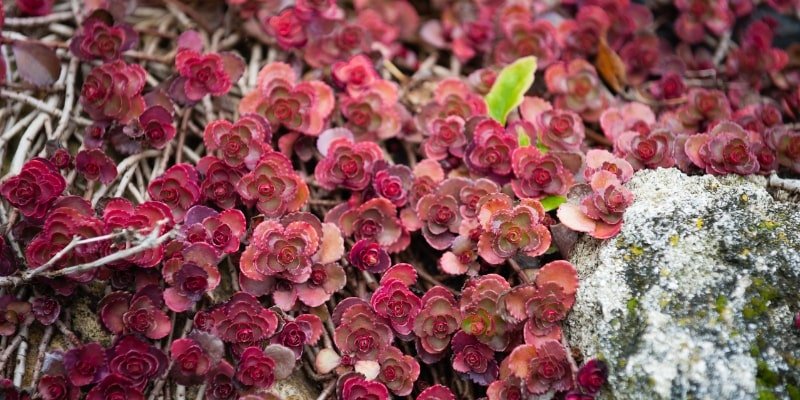
Scientific Name: Crassula pellucida ‘Variegata’
Plant Type: Perennial / Shrub
Plant Size: 5-6 inches
Watering Needs: 0.8 cups of water every 12 days
Sun Exposure: Full sun
The peculiar aspect of Calico Kitten is its distinctive appearance. The green, white, and brilliant pink leaves on this trailing, vining shrub have become slightly thicker. Overhanging pots and hanging baskets are covered in long branches covered in leaves.
To ensure that it remains compact and colourful, place this plant near a window that receives lots of light. You should definitely give your plant additional light if its stems are getting long and lanky. Since stems are pretty brittle, if a piece breaks off, it can be replanted in a fresh container filled with loose, succulent soil that drains properly.
57. Christmas cactus

Scientific Name: Schlumbergera spp.
Plant Type: Perennial
Plant Size: 3 feet long
Watering Needs: Up to a couple of times a week during the summer
Sun Exposure: Full Sun
The Christmas cactus is among the easiest succulents to find. Every year, usually from late autumn to early January, they blossom. Leaves with multiple sections are crowned by dramatic, ostentatious blossoms. Pink is a colour found in many flower varieties.
Water your Christmas cactus only when the soil is arid, usually once every two to three weeks. The ideal soil is loose and well-drained. Cactus and succulent-specific potting soil are suitable for these plants. Give your Christmas cacti a spot with bright but indirect sunlight, as they might burn if they get too much direct sunlight.
58. Donkey’s Tail

Scientific Name: Sedum morganianum
Plant Type: Perennial
Plant Size: 3-4 inches
Watering Needs: Allow its soil to dry out completely between watering
Sun Exposure: Lots of warm sunlight
Burro’s tail, sometimes known as donkey’s tail, is a common type of succulent. This plant grows slowly, like a dense mass of small, plump leaves draped over a trailing or hanging stalk. Although these plants have the capacity to develop to relatively large lengths, the hanging leaves and stems break quickly due to their fragility.
Select the Donkey’s Tail window to be in the sun. Allow it to spread out a bit in its new location. It will wrap itself over the pot’s edge, but it won’t get very tall. Watering Donkey’s Tail should only be done when the soil has completely dried.
You don’t have to worry about forgetting about it for a time because it can tolerate a considerable period of drought.
59. Lucky Heart Plant

Scientific Name: Hoya kerrii
Plant Type: Vine
Plant Size: 3-5 Tall
Watering Needs: Water it when the top inch of soil feels dry to the touch
Sun Exposure: Full Sun
Usually offered as a single leaf rooted in a pot, the Lucky Heart Plant gives the impression that a heart is developing in the ground. But that one leaf—which has developed roots—is just that—a single leaf and is not likely to develop into a whole plant.
You can multiply lucky heart plants by taking a cutting that has both a leaf and a stem node on it. The stem will produce a new stem from the base once it is fully planted.
A healthy Lucky Heart Plant can reach a maximum length of 12 feet on its stem, with thick, waxy heart-shaped leaves appearing every few inches if given enough room to grow. These lengthy vines can be trained to trail down from a hanging pot or along a sunny windowsill, or they can grow along an upright support.
60. String of Buttons
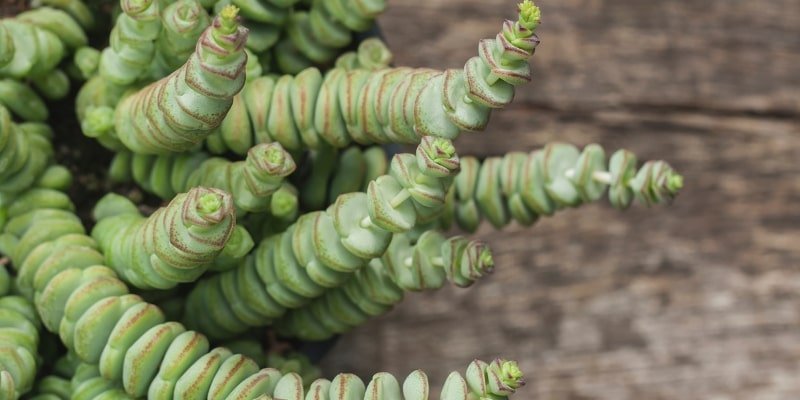
Scientific Name: Crassula perforata
Plant Type: Perennial
Plant Size: 3-5 inches
Watering Needs: Allow its soil to dry out completely between watering
Sun Exposure: Bright, full sunlight to light shade
As a houseplant, String of Buttons typically produces a more compact stem that can reach up to two feet long. Thick, meaty, widely triangular leaves are tightly packed along the stem. The overall shape of the leafy stem may appear nearly square due to the way the pairs of triangular leaves develop in opposite directions.
The leaves include attractive reddish-green speckling and edging. Bright, sunny windows are ideal for this pretty tiny plant. Though it usually keeps an upright growth habit instead of dangling over the edge, a string of buttons can grow over the pot’s edge in time.
61. Crown of Thorns

Scientific Name: Euphorbia milii
Plant Type: Perennial
Plant Size: 3 feet tall
Watering Needs: regular watering about once a week
Sun Exposure: Full sun to part shade
A normal succulent may not look like a crown of thorns. It has a large, succulent, woody trunk that is abundantly shielded by striking spines. Grown for its striking red blossoms, the Crown of Thorns is dangerous due to its sharp spines.
Grown indoors near a sunny window, this plant will happily blossom. Although the Crown of Thorns grows very slowly, you should repot it as needed and wear strong gloves when it gets taller and heavier.
62. Pencil Tree

Scientific Name: Euphorbia tirucalli
Plant Type: Shrub
Plant Size: 30 feet tall
Watering Needs: once every 10 days (at most) during the growing season
Sun Exposure: Full Sun
The pencil tree may be tall, but don’t let that deter you. Since these plants grow slowly, you may always prune them by cutting off some of the taller branches if they get too big for you.
Both people and animals can be poisoned by the red pencil tree. If you have small children or dogs that might inadvertently come into contact with this plant, do not grow it.
This plant produces a venomous sap that can irritate skin when touched and be fatal if swallowed. It is, however, an extremely interesting-looking plant if you can cultivate it in a secure location.
Conclusion
If you’re a plant collector or an inattentive caretaker searching for unusual plants that are more fascinating than your average monsteras or daisies, succulents are the ideal choice. Take home one of these gorgeous varieties of succulents for a sturdy, hefty plant that would look great on your sunny windowsill.

